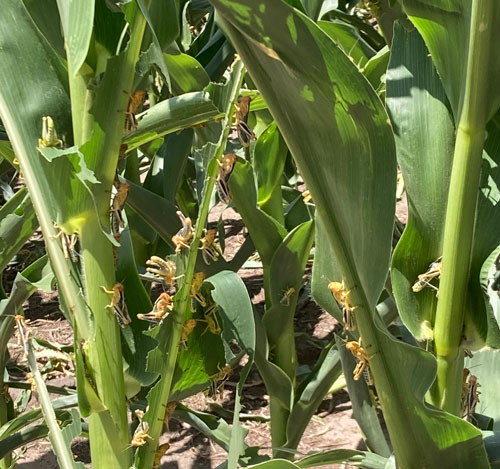Western Kansas is hopping this summer as the number of grasshoppers spikes.
Kansas State University Research and Extension entomologist Anthony Zukoff said wet weather patterns this spring are supporting the presence of large grasshopper populations across western and central portions of the state.
Zukoff said hot, dry summers increase the likelihood of young grasshoppers, or nymphs, surviving to adulthood. More adult grasshoppers mean increased egg production during cooler months. If the following spring is warm and wet, more eggs hatch and more nymphs can survive.
“So, several years of hot, dry summers followed by warm, wet springs can eventually lead to large populations of grasshoppers in some regions,” Zukoff said.
Ag producers in western Kansas will have lessened chances for rainfall over the next several days. The extended outlook from meteorologists at the National Weather Service office in Dodge City calls for thunderstorm chances to taper off and temperatures to remain around 90 degrees through the end of the month.
K-State assistant state climatologist Matt Sittel said the hottest point of the summer has passed, with five days in July registering above 100 degrees across much of the state.
Sittel said July 15 was the hottest day so far this year in Kansas, with an average high temperature across the Kansas Mesonet weather observation system of 102 degrees. At least 30 Mesonet sites reached 100 each day from July 12 to July 15. The hottest temperature reading of the year for Kansas came on July 13, when Webster Dam in Rooks County recorded a high of 111 degrees.
Sittel said the probabilities stretching into August favor above-normal temperatures and near-normal chances of precipitation for most of the state.
Zukoff said the extra rainfall in early spring has helped spur leafy plant growth, including broad-leaf weeds, which grasshoppers thrive in. Ag producers should be aware of higher-than-normal grasshopper numbers, but most crops should be mature enough to withstand some defoliation from grasshoppers eating them, according to Zukoff.
He said five to eight grasshoppers per square yard in corn or sorghum fields may be enough to warrant insecticide treatment.
“Later this season, fall-planted crops could be at risk, especially as alternate food sources are controlled or go dormant,” Zukoff said.
If an ag producer planting alfalfa finds 15 or more grasshoppers per square yard around the planting area, Zukoff recommends treating the area before planting.
For wheat, the vegetated borders around the planting areas should be scouted at least 10 days before planting, Zukoff said, with treatment recommended if there are seven to 12 grasshoppers per square yard.
Zukoff said three or more grasshoppers per square yard within a wheat field can destroy seedling wheat stands. Seed treatments can protect emerging wheat plants for several weeks, as long as the grasshopper population remains low.
_ _ _
Story via Kansas Reflector



